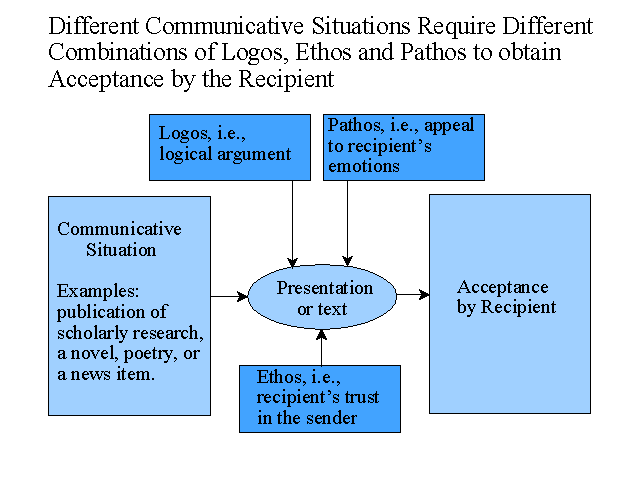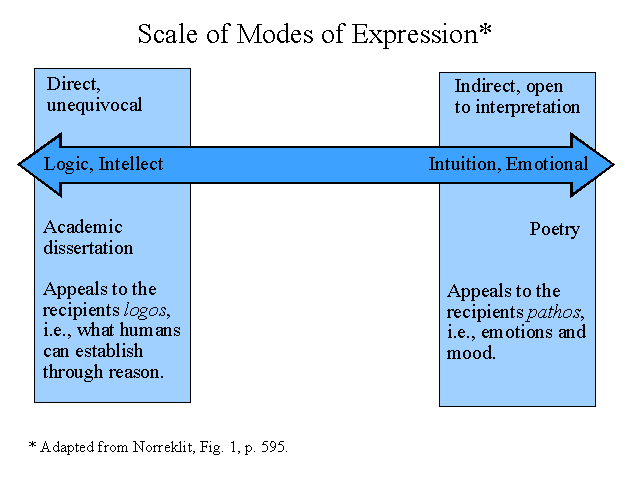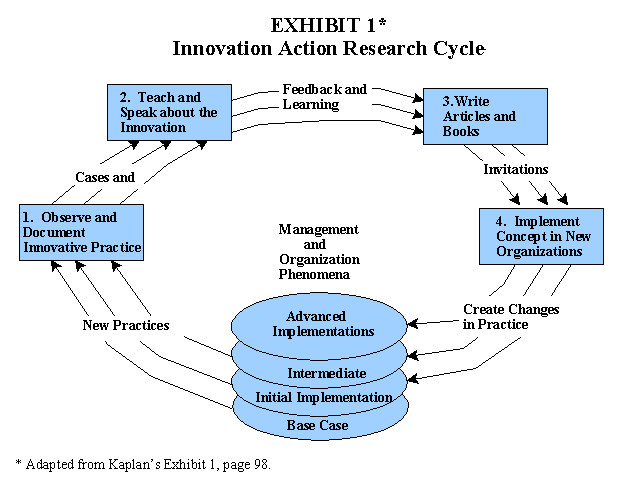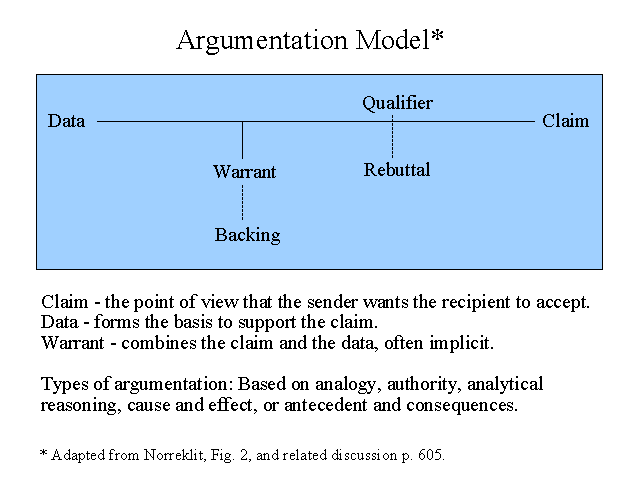
Summary by James R. Martin, Ph.D., CMA
Professor Emeritus, University of South Florida
Balanced Scorecard Main Page |
Controversial Issues Main Page
The purpose of this article is to analyze the book entitled The Balanced Scorecard 1 (BSC) to determine whether the attention given to the balanced scorecard results from a new and convincing theory, or is merely the result of persuasive rhetoric. The question is whether the BSC is persuasive and convincing, or just persuasive, where a convincing theory requires the elements of sound argumentation. The theme of the paper is that the BSC model is not theoretically innovative, convincing or valid.
Method
The method involves using argumentation analysis to follow the thought process through the text to represent the strength of the argumentation. The author uses a variety of rhetorical concepts to explain the analysis throughout the paper as noted in the sections below.
Sound Argumentation
An author (sender of communication or text) may gain the acceptance of the audience with ethos, pathos, and logos, where ethos relates to the trust the recipient has in the author (sender), pathos refers to the emotional appeal of the text, and logos refers to the logic and recipient's intellect associated with the text. The recipient's acceptance in all communication relies to some extent on all three concepts. An attempt to convey this idea appears in the graphic below based on my interpretation of the author's arguments.

However, scientific work (e.g., an academic dissertation) depends mainly on logos (logic) while a work open to interpretation such as poetry depends mainly on pathos (intuition and emotion). See the figure below for a graphic view of this continuum.

Analogies or metaphors may be used in scholarly arguments, but these rhetorical devices have several limitations and can also be used to hide bad arguments. They can be used to appeal to the recipient's emotions (pathos) with little or no valid underlying logic (logos). Therefore, when used in scientific work, such devices must be extended with logic rather than association.
The Communicative Situation
Kaplan and Norton use a method referred to as "innovation action research" illustrated in the graphic below from Kaplan's 1998 article.

Since the BSC is directed towards practitioners as well as academics, it needs to appeal to both logos and pathos to gain the recipient's acceptance, but this wide audience requires less emphasis on logic (logos) and perhaps more emphasis on creating excitement and emotional appeal (pathos).
Composition
In The Balanced Scorecard, Kaplan and Norton use the dramatic form (rather than the usual scholarly approach) drawing analogies (e.g., jet airplane & company, pilot & manager) to tell a story that builds to a climax. Briefly, the competitive environment has changed (from industrial age to information age), and navigating a company (as a jet aircraft) in this new environment requires a new model. Companies have tried various new techniques, but the results have been disappointing. The traditional accounting model is the problem. The balanced scorecard is the solution.
This story is engaging and persuasive, but according to Norreklit, the dramatic approach used in the BSC relies too much on emotional appeal (pathos) and the reputation/authority of Kaplan and Harvard (ethos), rather than on sound logical development (logos).
Stylistic Devices (Tropes and lexis)
In this section the author defines and discusses various devices (tropes) including metaphors (a link between an object and an image), analogies (linking several metaphors), metonymy (replacing something with an image), hyperbole (exaggerated terms), irony (word used to convey the opposite meaning of the word) and persuasive tools (lexis), antithesis (opposition in the meaning of ideas), loaded adjectives, imprecise and intertextuality based concepts. Norreklit is critical of how these devices are used, or misused, in the BSC. The text makes extensive use of analogies, loaded ambiguous metaphors, loaded adjectives, and metonymy that appeal to both pathos (emotion) and logos (reason), but violate the rules of sound argumentation leading to a lack of clarity, creating an illusion or false intellectual appeal (logos). There are ambiguous relationships between sentences and cases where the relation between the sentences has been omitted, or is not explicit. But in argumentative, or technical text, sentences need to be subordinated and coordinated. The BSC text relies on pathos rather than logos and forces readers to find a logical relationship by themselves.
Argumentation Analysis
Argumentation requires at least three elements including a claim, data, and a warrant (See graphic below). The BSC does not use argumentative concepts to link propositions. Various types of argumentation are discussed and compared to various passages in the BSC to show that the text does not use sound argumentation. Instead, the BSC text appeals mainly to pathos and ethos. The BSC is a conceptually unclear model that is based on attractive adjectives and extensive use of analogies and unrestrained metaphors. It is impressionistic and closely resembles propaganda with heavily loaded words, metaphors, irony, exaggerations, incoherence and a climax.

Putting the Results into Perspective
In this section the author provides some reasons why the works of various management gurus gain acceptance. For example, management theories have a legitimacy providing effect for both managers and academics, even when they do not have an efficiency enhancing effect for the organizations that attempt to use them. But academic use of guru theory to legitimize their own position is a misuse of academia since it is the duty of an academic to be skeptical of dubious theories.
More analysis of the type performed in the paper should be applied to academic text in management and accounting as well as to guru texts such as The Balanced Scorecard.
_____________________________________________
Related summaries:
Kaplan, R. S. 1998. Innovation action research: Creating new management theory and practice. Journal of Management Accounting Research (10): 89-118. (Summary).
Kaplan, R. S. and D. P. Norton. 1992. The balanced scorecard - Measures that drive performance. Harvard Business Review (January/February): 71-79. (Summary).
Kaplan, R. S. and D. P. Norton. 1996. The Balanced Scorecard: Translating Strategy into Action Boston: Harvard Business School Press. (Summary).
Kaplan, R. S. and D. P. Norton. 1996. The Balanced Scorecard: Translating Strategy into Action Boston: Harvard Business School Press. (Summary).
Kaplan, R. S. and D. P. Norton. 2001. The Strategy-Focused Organization: How Balanced Scorecard Companies Thrive in the New Business Environment. Harvard Business School Press. (Summary).
Kaplan, R. S. and D. P. Norton. 2001. Transforming the balanced scorecard from performance measurement to strategic management: Part I.
Accounting Horizons (March): 87-104. (Summary).
Kaplan, R. S. and D. P. Norton. 2001. Transforming the balanced scorecard from performance measurement to strategic
management: Part II. Accounting Horizons (June): 147-160. (Summary).
Kaplan, R. S. and D. P. Norton. 2004. Measuring the strategic readiness of intangible assets. Harvard Business Review (February): 52-63. (Summary).
Ittner, C. D. and D. F. Larcker. 2003. Coming up short on nonfinancial performance measurement. Harvard Business Review (November): 88-95. (Summary).
Lipe, M. and S. Salterio. 2000. The balanced scorecard: Judgmental effects of common and unique performance measures. The Accounting Review (July): 283-298. (Summary).
Lipe, M. G. and S. Salterio. 2002. A note on the judgmental effects of the balanced scorecard's information organization. Accounting, Organizations and Society 27(6): 531-540. (Summary).
Lyons, B., A. Gumbus and D. E. Bellhouse. 2003. Aligning capital investment decisions with the balanced scorecard. Journal of Cost Management (March/April): 34-38. (Summary).
Martin, J. R. Not dated. Balanced scorecard concepts. Management And Accounting Web. BalScoreSum.htm
Paladino, B. 2007. 5 key principles of corporate performance management: How do Balanced Scorecard Hall of Fame, Malcolm Baldrige, Sterling, Fortune 100, APQC, and Forbes award winners drive value? Strategic Finance (June): 39-45. (Note).
Schonberger, R. J. 2008. Lean performance management (Metrics don't add up). Cost Management (January/February): 5-10. (Note: Schonberger criticizes the KPI or scorecard approach from the lean enterprise perspective. Summary).
Zimmerman, J. L. 2001. Conjectures regarding empirical managerial accounting research. Journal of Accounting and Economics (32): 411-427. (Summary).